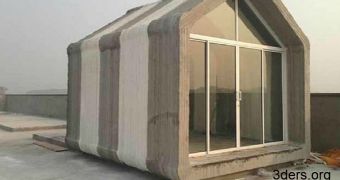We already know about a concrete 3D printer that can make a home in 24 hours, but it seems that there is a second printer out there somewhere, specifically in China. Because it's just been used to build a small bunkie.
And we don't just mean any bunkie. Bunkies are pretty small, wooden buildings, like little cabins in the woods or a particularly sophisticated lean-to.
The small building that Wisun created in Shanghai, however, is made of cement. Glass fiber reinforced cement to be precise.
Some might argue that the process used to make the building in the picture is not true 3D printing, because it's not “grown” that way.
Instead, Wisun used equipment that prints out layers which need to be lifted and put together, like bricks, sort of.
But the only way that argument will hold any water is if we disregard the fact that many, many 3D printed objects are actually assembled from 3D printed components instead of being made in a single round.
It's just hard to make large or particularly complex items with 3D printing. It's not possible to use more than one filament/resin tank, except for some multi-nozzle FFF printers that have no bearing on building printing.
Which brings us back to the topic at hand: the cement 3D printed house in Shanghai, which Winsun hopes will be followed by many others.
This is where we mention the best part: the printing material is actually construction waste, tailings and industrial waste that was recycled.
Winsun even hopes to build 100 recycling factories in the country, to collect and transform such waste into printing material it can then use to make more homes. Maybe we can look forward to larger, multi-room structures in the near future. 3D printing should, thus, help save up to 50% in terms of construction costs.
It's true that the so-called 3D printed house looks pretty strange, as if it's made of a bunch of layers of something that looks like plywood from certain angles. All squashed together. It really is cement though, reinforced with fiber glass. And this is more a proof of concept than anything else, so some allowances can be made.
Which is to say, we shouldn't wrinkle our noses at the aesthetic value (or lack thereof) because it does what it was made for: proves that 3D printing technology can be used to create buildings, and that it can even open new doors for waste recycling.

 14 DAY TRIAL //
14 DAY TRIAL //